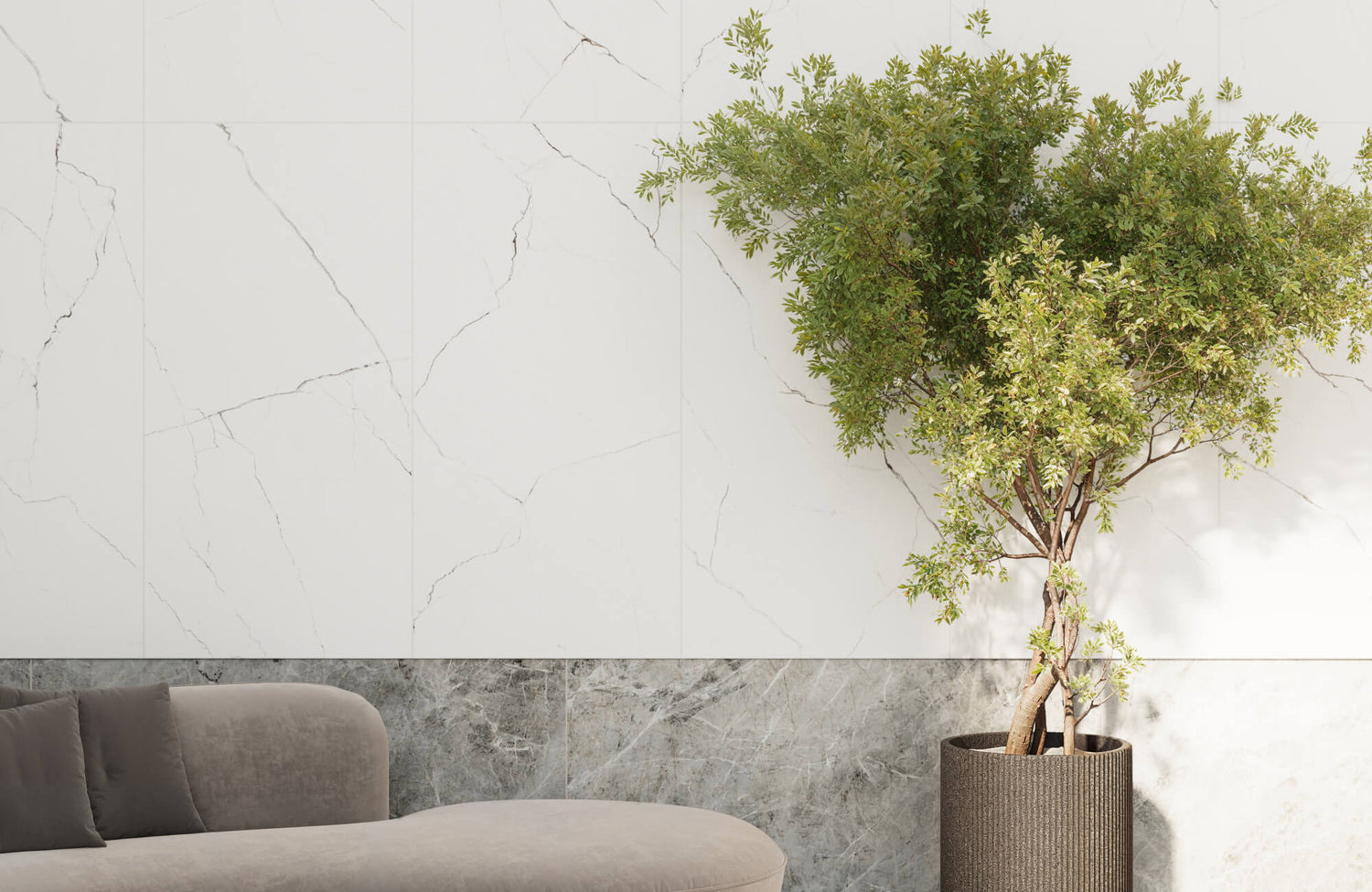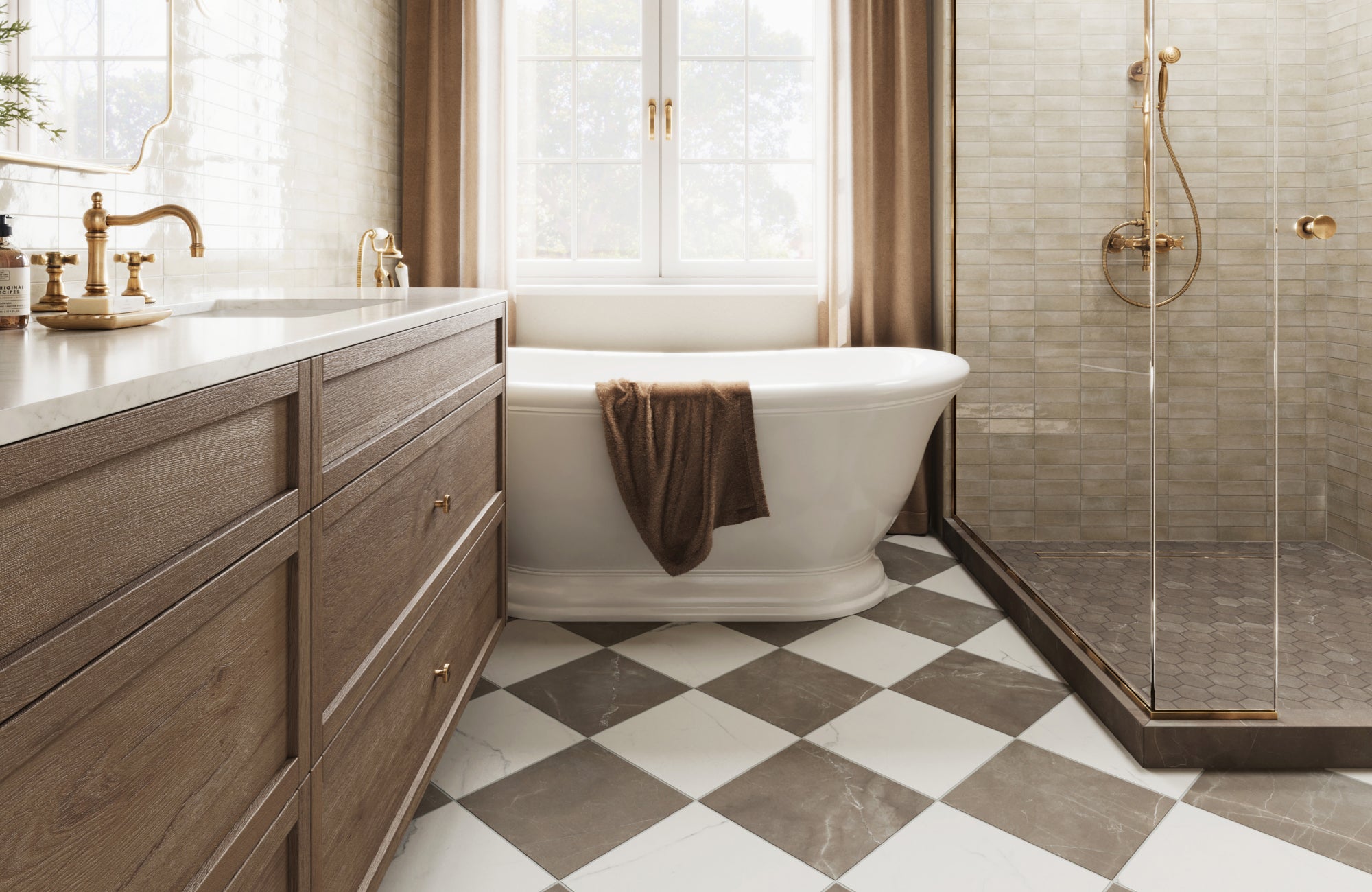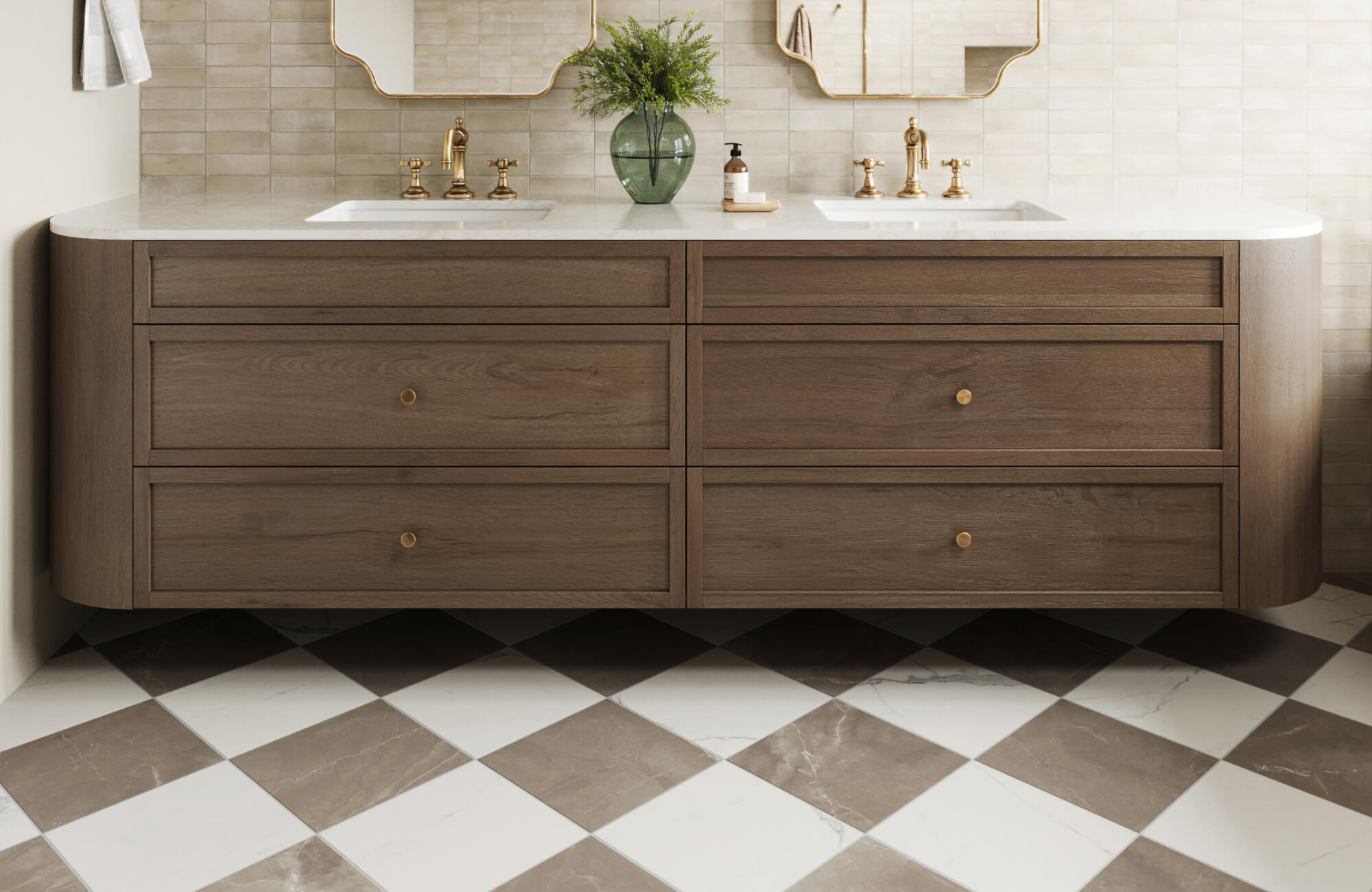Marble surfaces can bring timeless elegance to homes, but regular maintenance is essential to restore and preserve their shine. Over time, acidic spills, dirt buildup, and harsh cleaners can diminish marble’s natural luster, leaving it dull and worn. By understanding the unique characteristics of different marble types and applying proper cleaning and polishing techniques, homeowners can keep their surfaces looking as good as new.
In this article, we’ll outline the key steps to make your marble surface shine like new again—from selecting the best cleaning products to applying sealing techniques for lasting protection. We'll also introduce marble-look tiles as a practical, low-maintenance alternative that offers the beauty of marble without the high upkeep.

Marble Types and Dulling Causes
The durability and maintenance requirements of marble surfaces can vary by type. For instance, Carrara marble, such as our Aniston 24x48 Polished Porcelain Tile in Carrara Bianco shown on the right, has a soft, light appearance but is porous, making it susceptible to stains and dulling. In contrast, Calacatta marble, like our Aniston 24x48 Matte Porcelain Tile in Calacatta Viola featured in the photo on the left, is known for its bold veining and denser structure, which provides greater wear resistance. Likewise, Emperador marble's rich, dark tones highlight scratches and etching, emphasizing the importance of selecting the appropriate type based on the space and level of use.
Marble's shine can also fade over time due to daily use and exposure to harsh chemicals. For example, acidic spills, such as citrus or vinegar, can etch the surface, while abrasive cleaning tools leave scratches that diminish their natural shine. On top of that, dust and dirt can cause surface wear over time, particularly in busy areas. To prevent this, it is important to avoid common cleaning mistakes, such as using generic household cleaners not specifically designed for marble, as they can strip the protective finish and accelerate dulling. Proper care starts with understanding marble’s natural properties, ensuring its shine is preserved for years to come.

Preparation Before Polishing
Marble surfaces require thorough preparation to achieve a polished, high-gloss finish. Ensuring the right tools are ready beforehand allows the process to run smoothly and efficiently. Key supplies include a soft microfiber cloth, pH-neutral marble cleaner, and a high-quality polishing compound suitable for the marble type. In addition, using a variable-speed polisher or polishing pads can enhance the results and speed up the process. Having these essentials readily available helps prevent delays and minimizes the risk of damage from using improper materials.
Safety during marble polishing is equally important as gathering the right tools. Always remember to wear protective gloves to shield your hands from chemicals, and keep the workspace well-ventilated to reduce exposure to dust or fumes. It’s also advisable to avoid acidic or abrasive products that can etch the marble surface. Furthermore, placing protective coverings around the work area can help prevent splatter or accidental staining of nearby surfaces. By prioritizing safety, you can protect both yourself and the marble, ensuring a successful and damage-free polishing process.

Cleaning Your Marble Surface
Cleaning marble thoroughly is essential for preparing it for polishing, as it eliminates debris that could cause scratches. Before starting, check the manufacturer’s care guidelines for your specific marble, as different types may require unique cleaning methods. Begin by dusting or wiping the surface with a dry microfiber cloth to remove loose particles. Follow up with a damp cloth and a pH-neutral marble cleaner, applying gentle circular motions to lift dirt without harming the stone. For tougher spots, a soft brush or sponge can help, but scrubbing too vigorously may lead to etching or surface wear. To avoid water spots or streaking, rinse the surface with clean water and dry it immediately with a soft cloth.
Selecting the right cleaning solutions is just as important for preserving marble’s integrity. While commercial marble cleaners designed for natural stone are recommended, a simple mild soap and water mixture can also work well. Always test any solution on a small area first, as certain marble finishes may react differently. Avoid acidic substances like vinegar or lemon juice, as they can gradually erode the marble’s surface and weaken its natural shine.
Common mistakes to avoid include using abrasive pads, letting spills sit for too long, and overwetting the marble during cleaning. By relying on gentle, marble-safe products and careful techniques, you protect the surface and ensure it’s ready for polishing. Proper cleaning reduces the risk of damage and helps maintain the marble’s natural beauty over time.

Polishing Your Marble
Polishing marble effectively restores its shine and highlights the natural beauty of the stone. The process begins with selecting the right polishing compound for the specific type of marble. For instance, softer marbles like Carrara require gentler compounds, while harder varieties such as Calacatta can tolerate slightly more abrasive products. Apply a small amount of the compound to the marble’s surface and use a soft cloth or buffing pad to work it in circular motions by hand. This method works best for smaller areas or light dullness, although it demands patience and consistency to achieve a uniform sheen.
For larger surfaces or deeper dullness, a mechanical polisher can simplify the process and deliver faster results. Start at a low speed to prevent overheating or damage, then gradually increase as the compound spreads evenly. While mechanical polishers can produce a brilliant finish, they require careful handling to avoid streaks or overpolishing. Once complete, wipe away any remaining compound with a damp cloth, ensuring no residue is left behind. By following these steps and choosing the right tools, you can restore the marble’s luster while safeguarding its structure and appearance.

Sealing Your Marble
Sealing marble after polishing is essential for maintaining its shine and shielding it from stains, moisture, and daily wear. Since marble is naturally porous, it can easily absorb liquids and oils, leading to discoloration or etching over time. Applying a quality sealer creates a protective barrier that prevents these substances from penetrating the surface, preserving the polished look for longer. This protective measure becomes even more crucial in high-moisture areas like kitchens and bathrooms, where marble is frequently exposed to spills and humidity.
Selecting the right sealer also depends on the marble type and your desired level of protection. For a natural look, penetrating sealers are a great option, while topical sealers provide added shine and surface protection. Before applying, ensure the marble is thoroughly cleaned and dried. Spread the sealer evenly using a soft cloth or applicator, letting it absorb for the recommended duration before gently buffing away any excess. By incorporating sealing into the routine, marble surfaces become more durable and require less frequent polishing, allowing them to maintain their beauty and resilience over time.

Maintenance Tips for Shiny Marble
Maintaining marble’s shine requires consistent care to prevent dullness and surface damage. Incorporating daily and weekly routines helps preserve the stone’s natural gloss and ensures it stays looking polished. Wipe down surfaces daily with a soft, damp cloth or mop to remove dust and prevent buildup, and once a week, use a pH-neutral cleaner to keep the marble spotless without risking etching. Steer clear of harsh chemicals like vinegar or bleach, as they strip the marble’s finish. Additionally, small preventative measures—such as using coasters, mats, and trivets—help guard against scratches, stains, and heat damage from glassware or hot items.
When spills occur, immediate action is essential to avoid staining. Blot rather than wipe to prevent spreading the liquid, and treat the area with a mild soap solution or marble-safe cleaner. Avoid abrasive pads or scrubbing, as they can leave lasting marks on the surface. By developing these simple habits and being mindful of daily interactions with the marble, you can significantly extend its shine and lifespan, ensuring it remains a beautiful feature in your home for years.
Natural Remedies for Marble Shine
Restoring marble’s natural shine can also be achieved with simple, homemade solutions that are effective and eco-friendly. A baking soda paste, made by combining baking soda and water, gently buffs the surface when applied with a soft cloth, reviving the marble’s gloss. Cornstarch is another helpful remedy—lightly sprinkle it over the marble, then wipe it down with a damp cloth to lift dirt and enhance shine. These natural methods rejuvenate marble without relying on harsh chemicals that could degrade the surface over time.
Natural ingredients also provide a safer alternative for homes with children or pets, reducing the risk of accidental etching or staining. Unlike some commercial products, homemade solutions are gentle yet effective, offering sustainable ways to care for marble surfaces. However, it’s important to remember that natural remedies should complement, not replace, routine maintenance. By incorporating periodic DIY polishes alongside regular care, you can keep marble surfaces gleaming while reducing your environmental footprint.

Marble Look Tile Alternatives
Marble-look tiles offer a practical and stylish solution for homeowners seeking the luxurious appearance of natural marble without the associated upkeep. Crafted from durable materials such as porcelain and ceramic, these tiles closely mimic the veining and textures of real marble, delivering elegance at a fraction of the cost. Unlike natural marble, which can be susceptible to scratches, stains, and moisture, marble-look tiles are highly resistant to such damage. This makes them perfect for busy areas like kitchens, bathrooms, and outdoor spaces, where durability is essential without sacrificing style.
A standout advantage of marble-look tiles is their low maintenance. While natural marble requires frequent sealing, marble-look options like Edward Martin tiles require no sealing at all, minimizing both upkeep and long-term expenses. This feature alone simplifies care, ensuring that the tiles retain their polished appearance with minimal effort.
Marble-look tiles are also easier to install than natural marble, which is often fragile and challenging to handle. Their lighter weight and standardized sizes make them a flexible option for various applications, including flooring, backsplashes, and feature walls. Whether for contemporary or classic interiors, these tiles add timeless elegance while offering superior durability. For homeowners seeking lasting beauty without the maintenance demands of real stone, marble-look tiles present a compelling, long-lasting alternative.
If you want to see how the right marble look tiles can transform your home space, use our augmented reality (AR) tool to view different colors and finishes in real time. It's a great way to test out different options and see how each tile choice affects your interior design before making a final decision.
Key Takeaways
Restoring and maintaining the shine of marble surfaces enhances not only their appearance but also their longevity. By understanding the unique characteristics of different marble types and addressing common dulling causes, homeowners can take the necessary steps to preserve their surfaces. With consistent care, proper cleaning techniques, and regular polishing, marble can maintain its beauty for years to come. Moreover, sealing plays a vital role in protecting marble from stains and moisture, offering an extra layer of durability that extends its lifespan.
For those who love the elegance of marble but prefer a more practical, low-maintenance solution, marble-look tiles provide an excellent alternative. These tiles are especially well-suited for busy or moisture-prone areas, blending functionality with aesthetic appeal. Whether you're exploring options for your home or simply need advice on installation and care, feel free to contact us. Our team is here to help you select the best materials to achieve the perfect balance of style and durability for your space!







